Erythropoietin requires NF-kappaB and its nuclear translocation to prevent early and late apoptotic neuronal injury during beta-amyloid toxicity
- PMID: 16375720
- PMCID: PMC1986681
- DOI: 10.2174/156720205774962683
Erythropoietin requires NF-kappaB and its nuclear translocation to prevent early and late apoptotic neuronal injury during beta-amyloid toxicity
Abstract
No longer considered exclusive for the function of the hematopoietic system, erythropoietin (EPO) is now considered as a viable agent to address central nervous system injury in a variety of cellular systems that involve neuronal, vascular, and inflammatory cells. Yet, it remains unclear whether the protective capacity of EPO may be effective for chronic neurodegenerative disorders such as Alzheimer's disease (AD) that involve beta-amyloid (Abeta) apoptotic injury to hippocampal neurons. We therefore investigated whether EPO could prevent both early and late apoptotic injury during Abeta exposure in primary hippocampal neurons and assessed potential cellular pathways responsible for this protection. Primary hippocampal neuronal injury was evaluated by trypan blue dye exclusion, DNA fragmentation, membrane phosphatidylserine (PS) exposure, and nuclear factor-kappaB (NF-kappaB) expression with subcellular translocation. We show that EPO, in a concentration specific manner, is able to prevent the loss of both apoptotic genomic DNA integrity and cellular membrane asymmetry during Abeta exposure. This blockade of Abeta generated neuronal apoptosis by EPO is both necessary and sufficient, since protection by EPO is completely abolished by co-treatment with an anti-EPO neutralizing antibody. Furthermore, neuroprotection by EPO is closely linked to the expression of NF-kappaB p65 by preventing the degradation of this protein by Abeta and fostering the subcellular translocation of NF-kappaB p65 from the cytoplasm to the nucleus to allow the initiation of an anti-apoptotic program. In addition, EPO intimately relies upon NF-kappaB p65 to promote neuronal survival, since gene silencing of NF-kappaB p65 by RNA interference removes the protective capacity of EPO during Abeta exposure. Our work illustrates that EPO is an effective entity at the neuronal cellular level against Abeta toxicity and requires the close modulation of the NF-kappaB p65 pathway, suggesting that either EPO or NF-kappaB may be used as future potential therapeutic strategies for the management of chronic neurodegenerative disorders, such as AD.
Figures
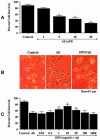
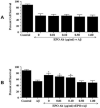

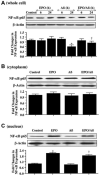
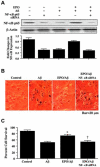
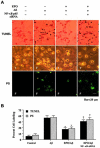
Similar articles
-
Erythropoietin prevents early and late neuronal demise through modulation of Akt1 and induction of caspase 1, 3, and 8.J Neurosci Res. 2003 Mar 1;71(5):659-69. doi: 10.1002/jnr.10528. J Neurosci Res. 2003. PMID: 12584724
-
Intranasal formulation of erythropoietin (EPO) showed potent protective activity against amyloid toxicity in the Aβ₂₅₋₃₅ non-transgenic mouse model of Alzheimer's disease.J Psychopharmacol. 2013 Nov;27(11):1044-57. doi: 10.1177/0269881113494939. Epub 2013 Jun 26. J Psychopharmacol. 2013. PMID: 23813967
-
Erythropoietin fosters both intrinsic and extrinsic neuronal protection through modulation of microglia, Akt1, Bad, and caspase-mediated pathways.Br J Pharmacol. 2003 Mar;138(6):1107-18. doi: 10.1038/sj.bjp.0705161. Br J Pharmacol. 2003. PMID: 12684267 Free PMC article.
-
Cell degeneration induced by amyloid-beta peptides: implications for Alzheimer's disease.J Mol Neurosci. 2004;23(1-2):97-104. doi: 10.1385/JMN:23:1-2:097. J Mol Neurosci. 2004. PMID: 15126695 Review.
-
New avenues of exploration for erythropoietin.JAMA. 2005 Jan 5;293(1):90-5. doi: 10.1001/jama.293.1.90. JAMA. 2005. PMID: 15632341 Free PMC article. Review.
Cited by
-
Cholinergic receptor pathways involved in apoptosis, cell proliferation and neuronal differentiation.Cell Commun Signal. 2009 Aug 27;7:20. doi: 10.1186/1478-811X-7-20. Cell Commun Signal. 2009. PMID: 19712465 Free PMC article.
-
Angiogenic responses are enhanced by recombinant human erythropoietin in a model of periventricular white matter damage of neonatal rats through EPOR-ERK1 signaling.J Neuropathol Exp Neurol. 2024 Feb 21;83(3):161-167. doi: 10.1093/jnen/nlae001. J Neuropathol Exp Neurol. 2024. PMID: 38263262 Free PMC article.
-
Charting a course for erythropoietin in traumatic brain injury.J Transl Sci. 2016 Mar;2(2):140-144. doi: 10.15761/jts.1000131. Epub 2016 Mar 26. J Transl Sci. 2016. PMID: 27081573 Free PMC article.
-
Contribution of hypoxia to Alzheimer's disease: is HIF-1alpha a mediator of neurodegeneration?Cell Mol Life Sci. 2009 Nov;66(22):3555-63. doi: 10.1007/s00018-009-0141-0. Epub 2009 Sep 11. Cell Mol Life Sci. 2009. PMID: 19763399 Free PMC article. Review.
-
Interplay between endothelin and erythropoietin in astroglia: the role in protection against hypoxia.Int J Mol Sci. 2014 Feb 19;15(2):2858-75. doi: 10.3390/ijms15022858. Int J Mol Sci. 2014. PMID: 24557580 Free PMC article.
References
-
- Bernaudin M, Marti HH, Roussel S, Divoux D, Nouvelot A, MacKenzie ET, Petit E. A potential role for erythropoietin in focal permanent cerebral ischemia in mice. J Cereb Blood Flow Metab. 1999;19(6):643–51. - PubMed
-
- Bittorf T, Buchse T, Sasse T, Jaster R, Brock J. Activation of the transcription factor NF-kappaB by the erythropoietin receptor: structural requirements and biological significance. Cell Signal. 2001;13(9):673–81. - PubMed
-
- Carvalho G, Lefaucheur C, Cherbonnier C, Metivier D, Chapel A, Pallardy M, Bourgeade MF, Charpentier B, Hirsch F, Kroemer G. Chemosensitization by erythropoietin through inhibition of the NF-kappaB rescue pathway. Oncogene. 2005;24(5):737–45. - PubMed
Publication types
MeSH terms
Substances
Grants and funding
LinkOut - more resources
Full Text Sources
Other Literature Sources
Medical
Research Materials
